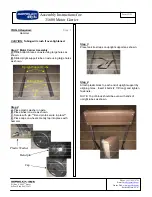
Basic Test Procedure
www.ti.com
4.2
Basic RF Test
Determine which balun device is placed on the board by inspecting which jumper resistor is installed at the
R101 to R105 locations. This information determines the proper RF frequencies for which the board is
configured.
summarizes the frequency band allocations.
Table 2. Frequency Allocations
Band
Frequency Band
F_LO
F_RF
1G9
1800 MHz to 2000 MHz
1.9 GHz
1.9 GHz
2G4
2.3 GHz to 2.7 GHz
2.4 GHz
2.4 GHz
3G5
3.5 GHZ to 3.8 GHz
3.5 GHz
3.5 GHz
1G7
1600 MHz to 1800 MHz
1.7 GHz
1.7 GHz
900M
700 MHz to 1000 MHz
900 MHz
900 MHz
1. Inject LO signal at J7 at F_LO frequency at 0 dBm. Compensate for RF cable losses, including about 1
dB for input balun and transmission line losses.
2. Verify USB cable is connected.
3. Launch TRF3711_GUI_vxpx.
4. Toggle Auto Cal En on the GUI to complete a dc offset calibration.
5. Monitor the dc voltage are TP2 (IA) and TP7 (IB) and between TP10 (QA) and TP12 (QB) and verify
that the dc offset voltage is 0 ±35 mV.
6. Inject RF signal at J6 at F_RF + 300 kHz at –40 dBm. Compensate for cable loss including about 1 dB
for input transmission line losses and balun.
7. Connect spectrum analyzer at J3 (I).
8. Set Spectrum analyzer center frequency to 300 kHz:
(a) Set span to 500 Hz.
(b) Set reference level to 0 dBm.
(c) Set analyzer to dc coupling.
(d) Set RBW to 3 Hz.
(e) Set VBW to 10 Hz.
9. Measure the signal at 300 kHz and verify signal at –12 dBm ±4 dB; note there is at least 12 dB of loss
associated through the onboard transformer. Also note that the device gain depends on the frequency,
and thus the output levels differ, depending on the frequency of the test.
10. Adjust BB gain to 20; verify signal reduces 4 dB ±1 dB.
11. Switch output cable to J10 (Q) and repeat the basic RF test beginning with Step 9..
4.3
Advanced RF Test
The EVM is equipped with the differential outputs going to a 16:1 transformer for interfacing with 50-
Ω
test
equipment. This configuration is suitable for completing basic RF test evaluation of the device; however,
the inherent high-pass nature of a transformer limits performance at frequencies close to dc. As a result,
this configuration is not suitable for analyzing true modulated signals. As an alternative, the ports at J2/J4
and J8/J13 offer direct access to the driver amplifier outputs for the differential I and Q signals,
respectively. Note, these ports cannot drive 50-
Ω
test equipment directly. For best performance, the
connections to the transformer should be severed by removing jumpers at W4, W5, W6, and W7.
6
TRF3711xxEVM
SLWU069B – February 2010 – Revised November 2010
Copyright © 2010, Texas Instruments Incorporated
































